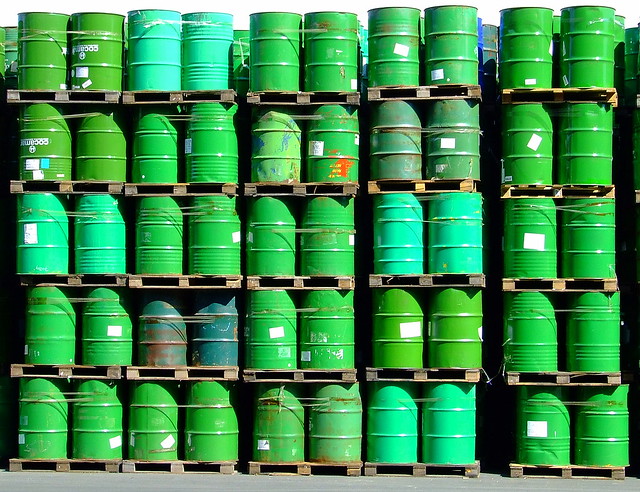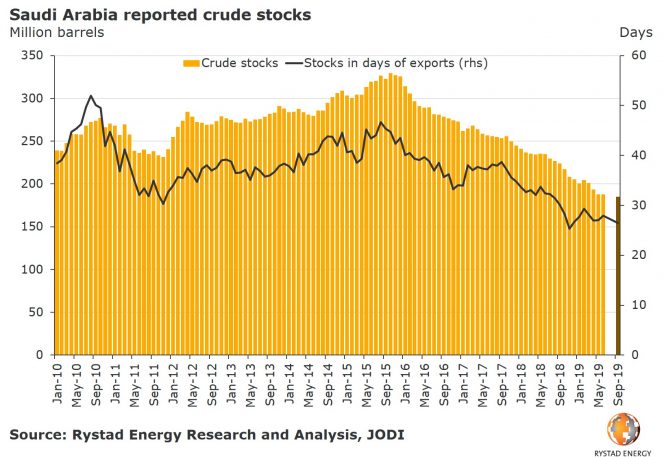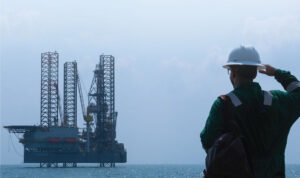Impact of Saudi oil attack on crude flows will depend on duration of outage, Rystad says
Oil prices on Monday saw the biggest surge since 1991 following a drone attack on the state-owned Saudi Aramco’s oil processing facility in Saudi Arabia, according to Reuters. The attack has shut down about 5% of the world’s crude output, but the impact of the attack on crude oil flows will depend on the duration of the outage, Rystad has said.


The world’s biggest crude oil processing facility, Abqaiq, was damaged in a drone attack on Saturday, September 14, 2019.
In a short statement on Saturday, Saudi Aramco said that its emergency crews had contained fires at its plants in Abqaiq and Khurais, as a result of terrorist attacks with projectiles.
These attacks resulted in production suspension of 5.7 million barrels of crude oil per day, according to the company.
After visiting the incident locations, Amin H. Nasser, Saudi Aramco President & CEO, said: “We are gratified that there were no injuries. I would like to thank all teams that responded timely to the incidents and brought the situation under control. Work is underway to restore production and a progress update will be provided in around 48 hours.”
The U.S. officials blamed Iran for the drone attack on Saudi facilities, but Iran denied blame, Reuters reported on Monday.
Oil prices surged by as much as 19% in early trade on Monday before easing off to show a 10% gain after the U.S. President Trump said he would release the U.S. emergency supplies, the news agency further said.
Saudi Arabia oil supply was attacked. There is reason to believe that we know the culprit, are locked and loaded depending on verification, but are waiting to hear from the Kingdom as to who they believe was the cause of this attack, and under what terms we would proceed!
— Donald J. Trump (@realDonaldTrump) September 15, 2019
….sufficient to keep the markets well-supplied. I have also informed all appropriate agencies to expedite approvals of the oil pipelines currently in the permitting process in Texas and various other States.
— Donald J. Trump (@realDonaldTrump) September 15, 2019
Bloomberg reported that oil briefly surged above $71 a barrel on Monday after the strike on the Saudi oil facilities. Prices have since pulled back by about half of the initial gain.
However, as Saudi officials are now less hopeful of rapid recovery, crude is still heading for the biggest advance in almost three years, according to Bloomberg.
Remember when Iran shot down a drone, saying knowingly that it was in their “airspace” when, in fact, it was nowhere close. They stuck strongly to that story knowing that it was a very big lie. Now they say that they had nothing to do with the attack on Saudi Arabia. We’ll see?
— Donald J. Trump (@realDonaldTrump) September 16, 2019
Rystad: Oil price spike likely short-lived
After the biggest attack on oil infrastructure since the Gulf War, Bjørnar Tonhaugen, head of oil market research at Rystad Energy, commented: “The bullish reaction in oil prices will likely be limited by Saudi Arabia’s vast quantities of crude in storage, estimated to equal roughly 26 days of current crude exports, a large portion of which is at the main export terminal Ras Tanura. The country also has strategic storage facilities in Rotterdam, Okinawa and Sidi Kerir (Egypt).”
The drone attack on the world’s largest oil processing facility, Abqaiq in the heart of Saudi Arabia’s oil industry, forced Saudi Aramco to shut in 5.7 million barrels per day (bpd) of crude production, Rystad Energy said.
“The world is not even close to being able to replace more than 5 million bpd day of Saudi Arabian exports. The market’s reaction to Saudi Arabia’s importance, in the new era of US shale, will now be put to the test,” Tonhaugen remarked.

The longer the processing facility remains disrupted, the larger the potential impact on actual crude flows will be.
“In a scenario where the damages result in a longer duration of the 5.7 million barrels per day production shut-in, say for 10 days or more, the situation for Saudi Arabian crude flows to the market will be critical, in our view, as there are limits globally to the volume of export replacement barrels,” Tonhaugen remarked.
“Strategic Petroleum Reserves in the OECD countries would then be called upon. The US stands as one of the few countries that would be able to increase exports in the short term. We believe US crude exports could potentially be increased by about 1 million bpd, from 3 million to 4 million bpd, if prices allow for higher utilization of the current crude exports capacity.
“Other countries with available capacity to increase exports by a few hundred thousand barrels per day each include UAE, Russia, Kuwait, and Iraq.”
Rystad noted that Saudi Arabia has approximately 185 million barrels of crude stocks in storage currently, and has drawn down its domestic crude stockpiles by more than 40% (or 140 million barrels) since 2015. A large part of the storage is located near crude loading terminals, with storage capacity at Ras Tanura estimated at 60 million to 70 million barrels, representing 10 to 11 days of normal crude exports from the terminal.
“The global flow of crude oil will not be disrupted immediately, Rystad Energy believes, due to storage capacity at the main export terminals. However, the longer the processing facility remains disrupted, the larger the potential impact on actual crude flows will be,” Tonhaugen added.
‘Situation in Middle East just got more fragile’
Commenting on reports of drone attacks against vital oil infrastructure in the Kingdom of Saudi Arabia, Per Magnus Nysveen, head of analysis at Rystad Energy, said: “The air attack by Iranian backed militia on vital oil processing terminals in the heart of Saud Arabia’s oil region has turned the market on its head over the weekend. From a situation of unprecedented global oversupply risks, the market will have to replace 5 million daily barrels of oil production by pulling from existing stocks until the oil facilities are brought back to safe operations.”
Nysveen added: “This could take a longer time than the authorities initially are claiming. Despite lower exports this year, Saudi Arabia has also depleted its crude oil stocks to the lowest levels in 10 years, so the country alone does not have the same robustness to Middle East interruptions as it used to have. Also, the US cannot quickly replace this volume, as it takes time to relocate oil tankers, and US still has limited export capacity by Very Large Crude Carriers (VLCC).
Bjørnar Tonhaugen, head of oil market analysis at Rystad Energy, commented: “This will trigger a significant pull-down of crude oil stocks held by Saudi Aramco, stocks that serve as a crucial security buffer in case of a blockade by Iran in the Strait of Hormuz. The immediate impact on crude prices could be around $10 per barrel and we expect the impact could be around 5 dollars for weeks, as the situation in the Middle East just got more fragile.”
Loss of supplies can’t be met for long by existing inventories
Commenting on the attacks, Wood Mackenzie VP for Refining, Chemicals an Oil Markets, Alan Gelder, said: “This attack has material implications for the oil market, as a loss of 5 million barrels per day of supplies from Saudi Arabia cannot be met for long by existing inventories and the limited spare capacity of the other OPEC+ group members.
“A geopolitical risk premium will return to the oil price,” Gelder added.
Impact on Asian markets: India most exposed
Wood Mackenzie research director, Vima Jayabalan, said: “Abqaiq and Khurais are main processing centers for Saudi Arabia’s Arab Extra Light and Arab Light crude oil.
“China, South Korea, Japan and India are the biggest takers in Asia, with China and Japan leading the pack at an average of 900 – 1,100 kilo barrels per day each. India could be most exposed as its reserves are the least. China has SPR (Strategic Petroleum Reserve) and commercial crude storage, while Korea and Japan have IEA reserves to fall back on.
“Collectively, Asian demand for Saudi Arabian crude is around 5 million barrels per day; accounting for almost 72% of Saudi Arabia’s crude exports. Asian consumption of Arab Extra Light and Arab Light grades alone from the affected facilities varies between 2.5 and 2.7 million barrels per day seasonally. The region’s dependence has increased significantly over the last 1.5 years.
“The impact and the next course of action will depend on the duration of the outage. Saudi Arabia has enough reserves to cover the shortfall over the next week, but if the outage extends, then filling the gap with the right type of crude quality could be a challenge. Moreover, OPEC+ output cut predominantly consists of medium and heavy sour crudes.
“In terms of refining and petrochemicals, the spike in crude oil prices will dent margins further.
“A prolonged outage and/or further upside above-ground risks in the near term could have an impact on the preparation ahead of the IMO marine bunker specifications change, but at the moment it is still early days to assess.”
Offshore Energy Today Staff
Spotted a typo? Have something more to add to the story? Maybe a nice photo? Contact our editorial team via email.
Also, if you’re interested in showcasing your company, product or technology on Offshore Energy Today, please contact us via our advertising form where you can also see our media kit.








